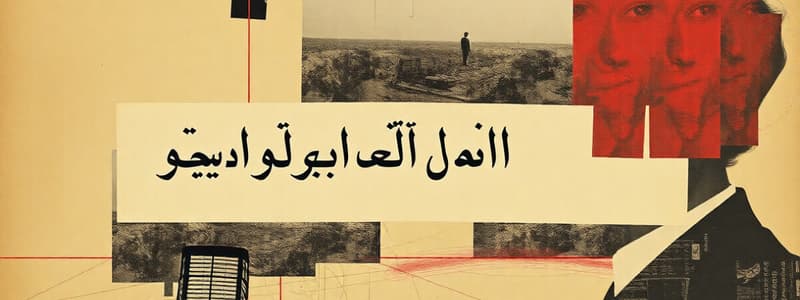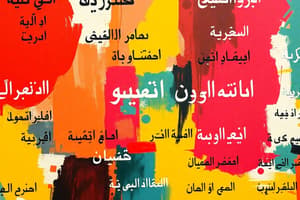Podcast
Questions and Answers
The Persian script utilizes the Latin alphabet as its foundation, with minor modifications.
The Persian script utilizes the Latin alphabet as its foundation, with minor modifications.
False (B)
Ferdowsi's Shahnameh is a short collection of poems focused on romantic themes.
Ferdowsi's Shahnameh is a short collection of poems focused on romantic themes.
False (B)
Calligraphy is NOT a valued art form in Persian culture.
Calligraphy is NOT a valued art form in Persian culture.
False (B)
The Safavid dynasty significantly contributed to Persian art, architecture, and the establishment of Shi'a Islam as the state religion.
The Safavid dynasty significantly contributed to Persian art, architecture, and the establishment of Shi'a Islam as the state religion.
Persian cuisine is known for its limited use of herbs and spices to preserve the natural flavors of the dishes.
Persian cuisine is known for its limited use of herbs and spices to preserve the natural flavors of the dishes.
Dari and Tajik are considered dialects of the Persian languages and are generally mutually intelligible.
Dari and Tajik are considered dialects of the Persian languages and are generally mutually intelligible.
Rumi's Gulistan is widely read and admired by both Persian speakers and non-Persian speakers around the world.
Rumi's Gulistan is widely read and admired by both Persian speakers and non-Persian speakers around the world.
The Qajar dynasty increased Persia's territory and sphere of influence during their rule in the 18th and 19th centuries.
The Qajar dynasty increased Persia's territory and sphere of influence during their rule in the 18th and 19th centuries.
Persian carpets are typically known for their simple, unadorned designs and lack of intricate details
Persian carpets are typically known for their simple, unadorned designs and lack of intricate details
The Achaemenid Empire, known for its efficient administration and religious tolerance, was eventually conquered by Julius Caesar.
The Achaemenid Empire, known for its efficient administration and religious tolerance, was eventually conquered by Julius Caesar.
Flashcards
Persian Language
Persian Language
Also known as Farsi, it's an Indo-European language spoken mainly in Iran, Afghanistan (Dari), and Tajikistan (Tajik).
Persian Script
Persian Script
Modified from Arabic, it includes extra letters for sounds unique to Persian.
Persian Literature
Persian Literature
A literary tradition spanning over two millennia, featuring poets like Ferdowsi, Rumi, and Hafez.
"Shahnameh"
"Shahnameh"
Signup and view all the flashcards
Rumi's "Masnavi"
Rumi's "Masnavi"
Signup and view all the flashcards
Persian Art
Persian Art
Signup and view all the flashcards
Calligraphy in Persian culture
Calligraphy in Persian culture
Signup and view all the flashcards
Achaemenid Empire
Achaemenid Empire
Signup and view all the flashcards
Safavid Dynasty
Safavid Dynasty
Signup and view all the flashcards
Persian Cuisine
Persian Cuisine
Signup and view all the flashcards
Study Notes
- Persian encompasses language, literature, art, history, and cuisine of Persia (modern-day Iran) and its cultural sphere
Persian Language
- Persian, also known as Farsi, is an Indo-European language in the Iranian branch.
- It is spoken in Iran, Afghanistan (Dari), and Tajikistan (Tajik).
- Persian has a long literary tradition, over a millennium.
- The Persian script is a modified Arabic script with letters for sounds not in Arabic.
- Persian grammar is simpler than many Indo-European languages, with few inflections.
- Its vocabulary is influenced by Arabic, Turkish, French, and English.
- Modern Persian has three dialects: Iranian Persian, Dari, and Tajik.
- The dialects are mutually intelligible despite pronunciation and vocabulary differences.
- Persian served as a lingua franca in parts of the Middle East, Central Asia, and South Asia.
Persian Literature
- Persian literature is one of the world's oldest and richest literary traditions, spanning over two millennia.
- Classical Persian literature peaked in the medieval period, with poets like Ferdowsi, Rumi, Hafez, Saadi, and Omar Khayyam.
- Ferdowsi's "Shahnameh" (Book of Kings) is Iran's national epic and one of the longest epic poems.
- Rumi's mystical poetry, especially his "Masnavi," is widely admired.
- Hafez is known for ghazals on love, mysticism, and social critique.
- Saadi is known for didactic works like "Gulistan" (The Rose Garden) and "Bustan" (The Orchard), offering moral guidance.
- Omar Khayyam is famous for "Rubaiyat," quatrains reflecting on mortality, pleasure, and life's meaning.
- Modern Persian literature is influenced by Western trends but draws from its classical heritage.
- Prominent modern writers include Sadegh Hedayat, Forough Farrokhzad, and Ahmad Shamlou.
Persian Art
- Persian art includes calligraphy, miniature painting, carpet weaving, ceramics, metalwork, and architecture.
- Calligraphy is valued and used to decorate religious and literary texts and monuments.
- Persian miniature painting features intricate details, vibrant colors, and stylized figures.
- Persian carpets are known for beauty, craftsmanship, and intricate designs.
- Persian ceramics have a long history and distinctive glazes and motifs.
- Metalwork is an important tradition, with artisans creating vessels, weapons, and jewelry.
- Persian architecture features grand scale, ornamentation, and materials like brick, tile, and stucco.
- Notable architecture includes mosques, palaces, and gardens in Isfahan and Shiraz.
- Persian art has been influenced by Greek, Roman, Chinese, and Islamic art.
Persian History
- Persian history dates back millennia, with Paleolithic human settlement.
- The Achaemenid Empire (c. 550-330 BCE) was one of the largest and most powerful.
- Cyrus the Great founded the Achaemenid Empire, which peaked under Darius I and Xerxes I.
- The Achaemenid Empire was known for its efficient administration, religious tolerance, and infrastructure like the Royal Road.
- Alexander the Great conquered the Achaemenid Empire in the 4th century BCE, leading to the Hellenistic period.
- After Alexander, Persia was ruled by the Seleucid Empire, then the Parthian Empire (c. 247 BCE-224 CE).
- The Sasanian Empire (224-651 CE) was the last pre-Islamic Persian empire and a major rival of the Roman and Byzantine Empires.
- The Sasanian Empire contributed to art, architecture, and literature; Zoroastrianism was the state religion.
- The Islamic conquest of Persia in the 7th century CE marked a turning point.
- Persia became part of the Islamic world, adopting Islam.
- Persian language and culture thrived and influenced Islamic civilization.
- Persia was ruled by Islamic dynasties, including the Abbasids, Samanids, Buyids, and Seljuks.
- The Mongol invasion in the 13th century CE caused destruction and upheaval.
- The Safavid dynasty (1501-1736) unified Persia and established Shi'a Islam as the state religion.
- The Safavid era was a golden age for Persian art, architecture, and culture.
- In the 18th and 19th centuries, Persia faced pressure from Russia and Great Britain.
- The Qajar dynasty (1789-1925) ruled during this decline.
- The Pahlavi dynasty (1925-1979) modernized Persia but was overthrown by the 1979 Islamic Revolution.
- The Islamic Republic of Iran was established in 1979.
Persian Cuisine
- Persian cuisine uses fresh herbs, spices, fruits, and nuts.
- Rice is a staple, served with stews, kebabs, and other dishes.
- Common dishes include kebab, khoresh (stew), polo (rice dish), and ash (soup).
- Saffron is widely used, giving dishes a distinctive flavor and color.
- Popular desserts include baklava, gaz (nougat), and faloodeh (frozen dessert with vermicelli noodles).
- Tea is a popular beverage, served with sweets or pastries.
- Persian cuisine varies regionally, each area having specialties.
- Persian food culture emphasizes hospitality and sharing meals with family and friends.
Studying That Suits You
Use AI to generate personalized quizzes and flashcards to suit your learning preferences.



